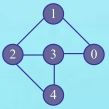- /*
- Copyright (c)2016,烟台大学计算机与控制工程学院
- All rights reserved.
- 文件名称:tu.pp
- 作 者: 陈朋
- 完成日期:2016年11月24日
- 版 本 号:v1.0
- 问题描述:
- 输入描述:无
- 程序输出:若干。
- */
1、深度优先遍历——DFS(程序中graph.h是图存储结构的“ 算法 库”中的头文件,详情请 单击链接… )
- #include <stdio.h>
- #include <malloc.h>
- #include "graph.h"
- int visited[MAXV];
- void DFS(ALGraph *G, int v)
- {
- ArcNode *p;
- int w;
- visited[v]=1;
- printf("%d ", v);
- p=G->adjlist[v].firstarc;
- while (p!=NULL)
- {
- w=p->adjvex;
- if (visited[w]==0)
- DFS(G,w);
- p=p->nextarc;
- }
- }
- int main()
- {
- int i;
- ALGraph *G;
- int A[5][5]=
- {
- {0,1,0,1,0},
- {1,0,1,0,0},
- {0,1,0,1,1},
- {1,0,1,0,1},
- {0,0,1,1,0}
- };
- ArrayToList(A[0], 5, G);
- for(i=0; i<MAXV; i++) visited[i]=0;
- printf(" 由2开始深度遍历:");
- DFS(G, 2);
- printf("\n");
- for(i=0; i<MAXV; i++) visited[i]=0;
- printf(" 由0开始深度遍历:");
- DFS(G, 0);
- printf("\n");
- return 0;
- }
测试 时用的图是
 ,可以使用其他类型的图代替。
,可以使用其他类型的图代替。
2、广度优先遍历——BFS(程序中graph.h是图存储结构的“算法库”中的头文件,详情请单击链接…)
- #include <stdio.h>
- #include <malloc.h>
- #include "graph.h"
- void BFS(ALGraph *G, int v)
- {
- ArcNode *p;
- int w,i;
- int queue[MAXV],front=0,rear=0; //定义循环队列
- int visited[MAXV]; //定义存放节点的访问标志的数组
- for (i=0; i<G->n; i++) visited[i]=0; //访问标志数组初始化
- printf("%2d",v); //输出被访问顶点的编号
- visited[v]=1; //置已访问标记
- rear=(rear+1)%MAXV;
- queue[rear]=v; //v进队
- while (front!=rear) //若队列不空时循环
- {
- front=(front+1)%MAXV;
- w=queue[front]; //出队并赋给w
- p=G->adjlist[w].firstarc; //找w的第一个的邻接点
- while (p!=NULL)
- {
- if (visited[p->adjvex]==0)
- {
- printf("%2d",p->adjvex); //访问之
- visited[p->adjvex]=1;
- rear=(rear+1)%MAXV; //该顶点进队
- queue[rear]=p->adjvex;
- }
- p=p->nextarc; //找下一个邻接顶点
- }
- }
- printf("\n");
- }
- int main()
- {
- ALGraph *G;
- int A[5][5]=
- {
- {0,1,0,1,0},
- {1,0,1,0,0},
- {0,1,0,1,1},
- {1,0,1,0,1},
- {0,0,1,1,0}
- };
- ArrayToList(A[0], 5, G);
- printf(" 由2开始广度遍历:");
- BFS(G, 2);
- printf(" 由0开始广度遍历:");
- BFS(G, 0);
- return 0;
- }
























 被折叠的 条评论
为什么被折叠?
被折叠的 条评论
为什么被折叠?








